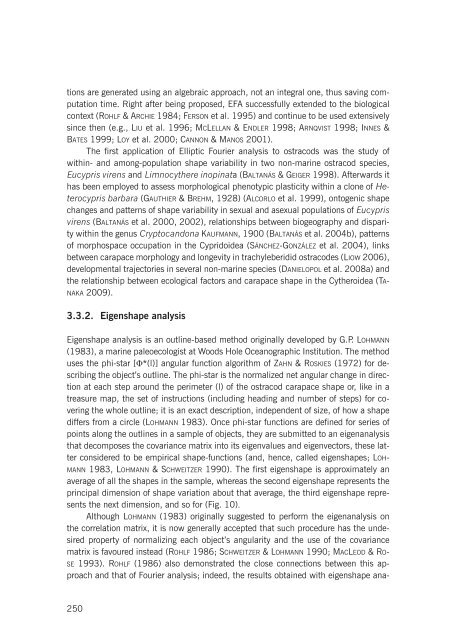Geo11_89_Baltanas_Danielopol_Geometric_Morphometrics
Geo11_89_Baltanas_Danielopol_Geometric_Morphometrics
Geo11_89_Baltanas_Danielopol_Geometric_Morphometrics
Create successful ePaper yourself
Turn your PDF publications into a flip-book with our unique Google optimized e-Paper software.
tions are generated using an algebraic approach, not an integral one, thus saving computation<br />
time. Right after being proposed, EFA successfully extended to the biological<br />
context (ROHLF & ARCHIE 1984; FERSON et al. 1995) and continue to be used extensively<br />
since then (e.g., LIU et al. 1996; MCLELLAN & ENDLER 1998; ARNQVIST 1998; INNES &<br />
BATES 1999; LOY et al. 2000; CANNON & MANOS 2001).<br />
The first application of Elliptic Fourier analysis to ostracods was the study of<br />
within- and among-population shape variability in two non-marine ostracod species,<br />
Eucypris virens and Limnocythere inopinata (BALTANÁS & GEIGER 1998). Afterwards it<br />
has been employed to assess morphological phenotypic plasticity within a clone of Heterocypris<br />
barbara (GAUTHIER & BREHM, 1928) (ALCORLO et al. 1999), ontogenic shape<br />
changes and patterns of shape variability in sexual and asexual populations of Eucypris<br />
virens (BALTANÁS et al. 2000, 2002), relationships between biogeography and disparity<br />
within the genus Cryptocandona KAUFMANN, 1900 (BALTANÁS et al. 2004b), patterns<br />
of morphospace occupation in the Cypridoidea (SÁNCHEZ-GONZÁLEZ et al. 2004), links<br />
between carapace morphology and longevity in trachyleberidid ostracodes (LIOW 2006),<br />
developmental trajectories in several non-marine species (DANIELOPOL et al. 2008a) and<br />
the relationship between ecological factors and carapace shape in the Cytheroidea (TA-<br />
NAKA 2009).<br />
3.3.2. Eigenshape analysis<br />
Eigenshape analysis is an outline-based method originally developed by G.P. LOHMANN<br />
(1983), a marine paleoecologist at Woods Hole Oceanographic Institution. The method<br />
uses the phi-star [Φ*(l)] angular function algorithm of ZAHN & ROSKIES (1972) for describing<br />
the object’s outline. The phi-star is the normalized net angular change in direction<br />
at each step around the perimeter (l) of the ostracod carapace shape or, like in a<br />
treasure map, the set of instructions (including heading and number of steps) for covering<br />
the whole outline; it is an exact description, independent of size, of how a shape<br />
differs from a circle (LOHMANN 1983). Once phi-star functions are defined for series of<br />
points along the outlines in a sample of objects, they are submitted to an eigenanalysis<br />
that decomposes the covariance matrix into its eigenvalues and eigenvectors, these latter<br />
considered to be empirical shape-functions (and, hence, called eigenshapes; LOH-<br />
MANN 1983, LOHMANN & SCHWEITZER 1990). The first eigenshape is approximately an<br />
average of all the shapes in the sample, whereas the second eigenshape represents the<br />
principal dimension of shape variation about that average, the third eigenshape represents<br />
the next dimension, and so for (Fig. 10).<br />
Although LOHMANN (1983) originally suggested to perform the eigenanalysis on<br />
the correlation matrix, it is now generally accepted that such procedure has the undesired<br />
property of normalizing each object’s angularity and the use of the covariance<br />
matrix is favoured instead (ROHLF 1986; SCHWEITZER & LOHMANN 1990; MACLEOD & RO-<br />
SE 1993). ROHLF (1986) also demonstrated the close connections between this approach<br />
and that of Fourier analysis; indeed, the results obtained with eigenshape ana-<br />
250


